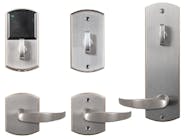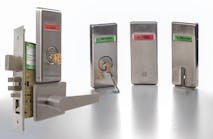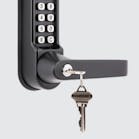If you see a plus sign (+) above the keyway on a Schlage residential lockset, you could say it is a sign of the times. Schlage introduced the new SecureKey rekeyable lock system in January. A plus sign on the lock plug is used as an indicator showing that the lock contains new SecureKey rekeyable features.
The cylinders use a sidebar locking system and require no top pin drivers. Schlage literature states that the lock is bump and pick resistant and meets UL 437, section 11.6 standards. This is certainly understandable since there are no traditional drivers and no normal shearline to bypass by bumping.
Each tumbler assembly contains extensions. When in a locked position, the extensions rest in holes cut into the cylinder housing. This combination of locked extensions and sidebar acts as a dual locking system to deter picking.
The SecureKey is a five-pin lock cylinder and uses a “C” keyway which can be set to operate with keys having original Schlage depth and space dimensioning. Schlage claims that SecureKey is “Ten Times More Secure” because of the number of key changes they have available. Boxes are marked with a 10x logo.
Products tested for this article included a Georgian knob lock and a Flair design lever lock, both having an accompanying Grade 1 deadbolt lock. In addition, Schlage plans to add SecureKey technology to their line of residential handlesets.
REKEYING PROCEDURE
Schlage locks having SecureKey technology are supplied with two operating keys, one Reset key cut to the same combination as the operating keys, and one uncut Reset key. Reset keys are light blue in color to distinguish them from operating keys. The user must obtain a new set of Schlage five-pin keys cut to factory depth/space specifications. Cuts of the new keys must be duplicated onto an uncut Reset blank. Care must be exercised when duplicating Reset keys because the blade material is thinner than standard “C” operating keys.
Step 1. Fully insert the blue reset key having the existing operating cuts and turn the lock cylinder plug counter-clockwise to approximately 11 o’clock.
Step 2. Keep the cylinder at 11 o’clock and remove the blue Reset key.
Step 3. Fully insert the blue Reset key which contains the new combination of cuts.
Step 4. Turn the blue Reset key back to 12 o’clock and remove the Reset key.
Step 5. Test the new operating keys and save the blue Reset key containing the new cuts in a safe place for future rekeying needs.
HOW IT WORKS
The lock plug is basically divided in two halves. The left side contains sidebar locking parts and the right side contains tumbler parts. An internal retainer holds the two halves together. As long as the two parts are held together, a projection on each tumbler is connected to one of a series of spline grooves in a corresponding sidebar operator. Key codes are determined by which spline groove each tumbler is connected to.
As a correctly cut Reset key is inserted and turned to 11 o’clock, it moves the internal retainer to a neutral position and the two halves of the lock plug are then separated by spring pressure. This action disconnects the tumblers from the sidebar operators.
As a Reset key with different key cuts is inserted into the lock plug, the tumblers are held at the height positions of the new key cuts. The action of turning the Reset key back to the 12 o’clock position forces the two cylinder halves together again and the tumbler projections enter new spline groove positions as required by the new key combination. Removal of the Reset key at the 12 o’clock position allows the spring-driven internal retainer to move to a closed position and the two halves are again held together. The combination has been changed.
Note: There are numerous small parts and springs within the SecureKey cylinder housing. During original factory assembly a spring cap is permanently fastened in place. Several of the small parts are under spring pressure. There are no serviceable parts within the housing and disassembly of the SecureKey cylinder is not recommended.
For further information contact your local locksmith distributor or visit the web site www.SecureKey.Schlage.com. Additional procedures for working with SecureKey locks will be discussed in a future Locksmith Ledger article.
To read additional Locksmith Ledger articles on Schlage deadbolt locks, visit Web Site: www. tinyurl.com/schlage0310




